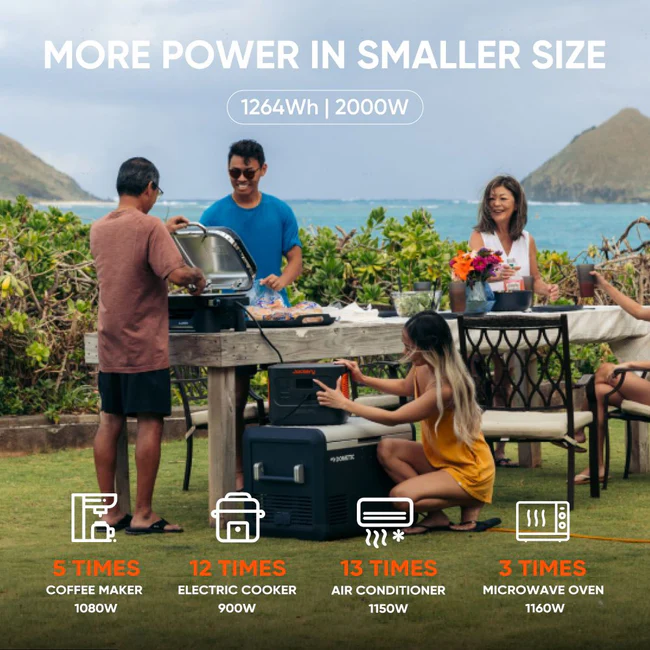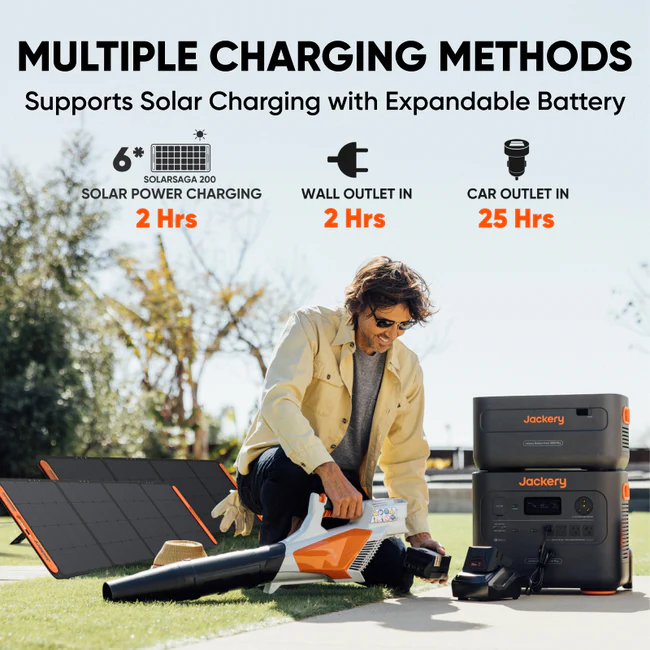6 Best Portable Power Stations for Emergency
If there’s one thing I’ve learned over the past few years, it’s that you can’t always count on the grid. Whether it’s a sudden storm, wildfire, or just an unexpected blackout, being without power can turn from inconvenient to dangerous fast. That’s why having a reliable backup solution isn’t just smart, it’s essential. In moments like these, a portable power station for Emergencies can make all the difference between staying safe and being stuck in the dark.
Now, if you’re not familiar with them, portable power stations are essentially compact, battery-powered generators. They don’t run on gas, they don’t make noise, and many of them can even be recharged using solar panels. What I love about them is how versatile they are—you can power up your phone, laptop, fridge, or even a medical device, all without relying on the traditional grid.
Let me walk you through the top portable power stations that I believe are genuinely worth considering for emergency use. Whether you’re preparing for storm season or just want peace of mind, these picks are reliable, efficient, and tested to handle real-life situations when power suddenly becomes a luxury.
| Purpose | How They Looks | Model Recommendation |
| Versatility and power | 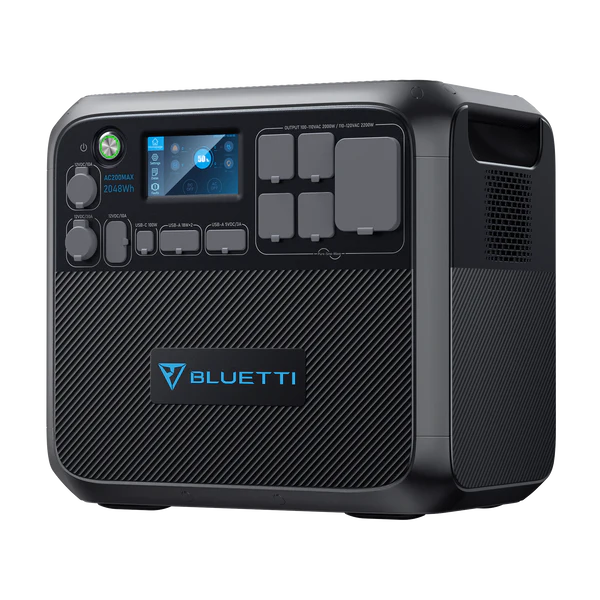 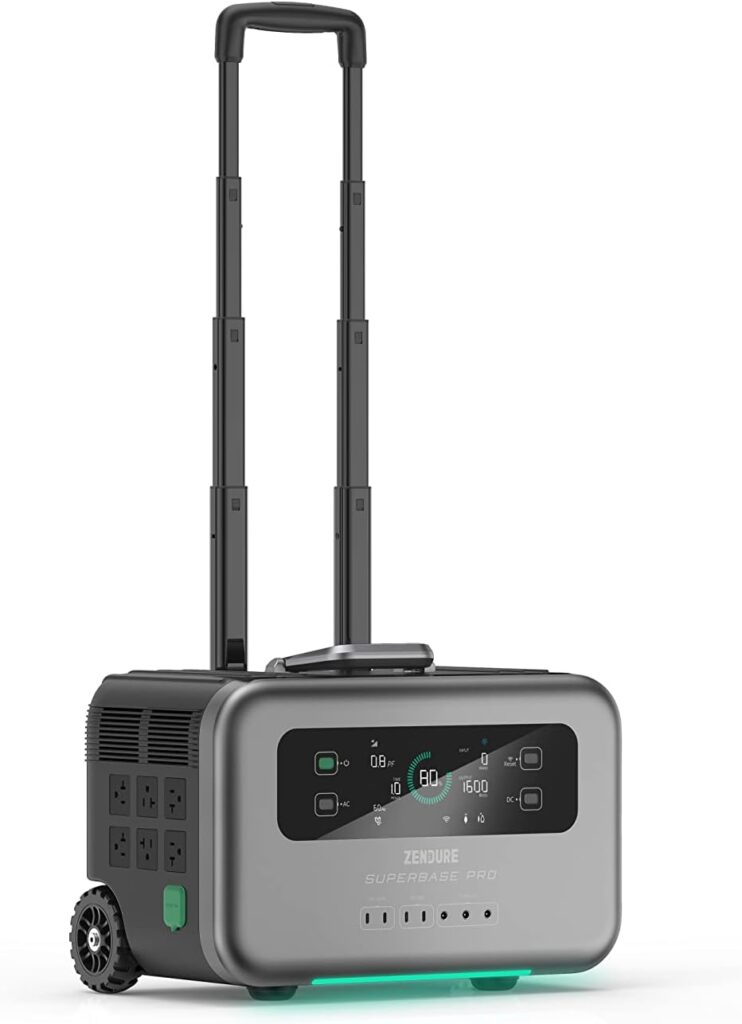 | Bluetti AC200MAX or Zendure SuperBase Pro 2000 |
| Speed and smart features | 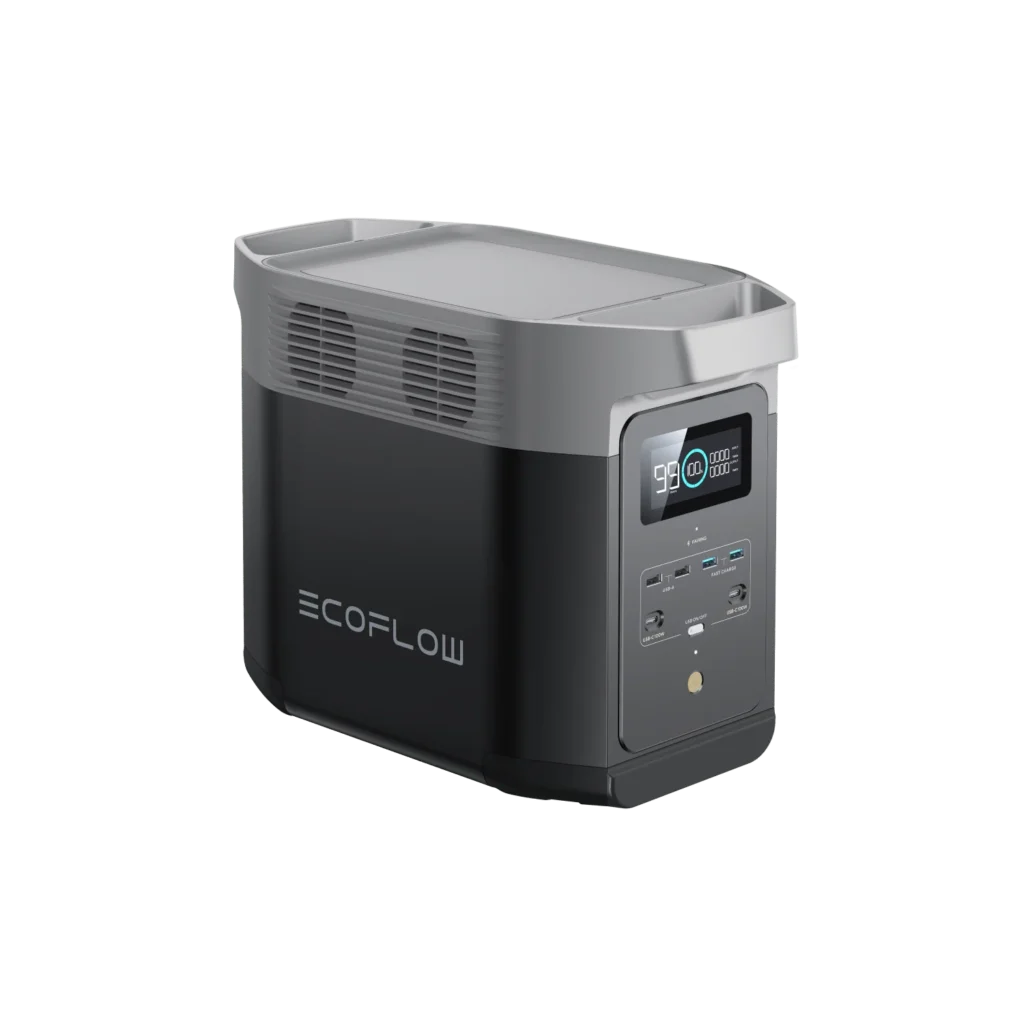 | EcoFlow DELTA 2 |
| Lighter needs or tight budgets | 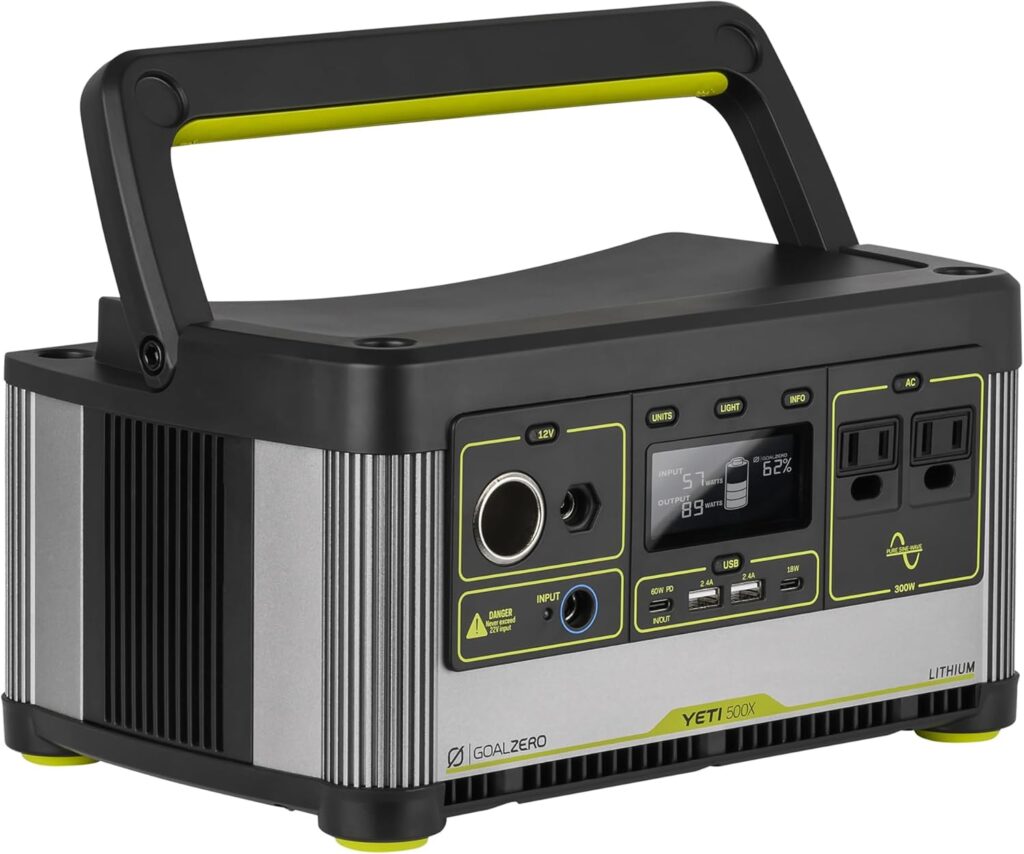 | Goal Zero Yeti 500X |
| All-around durability and a great build | 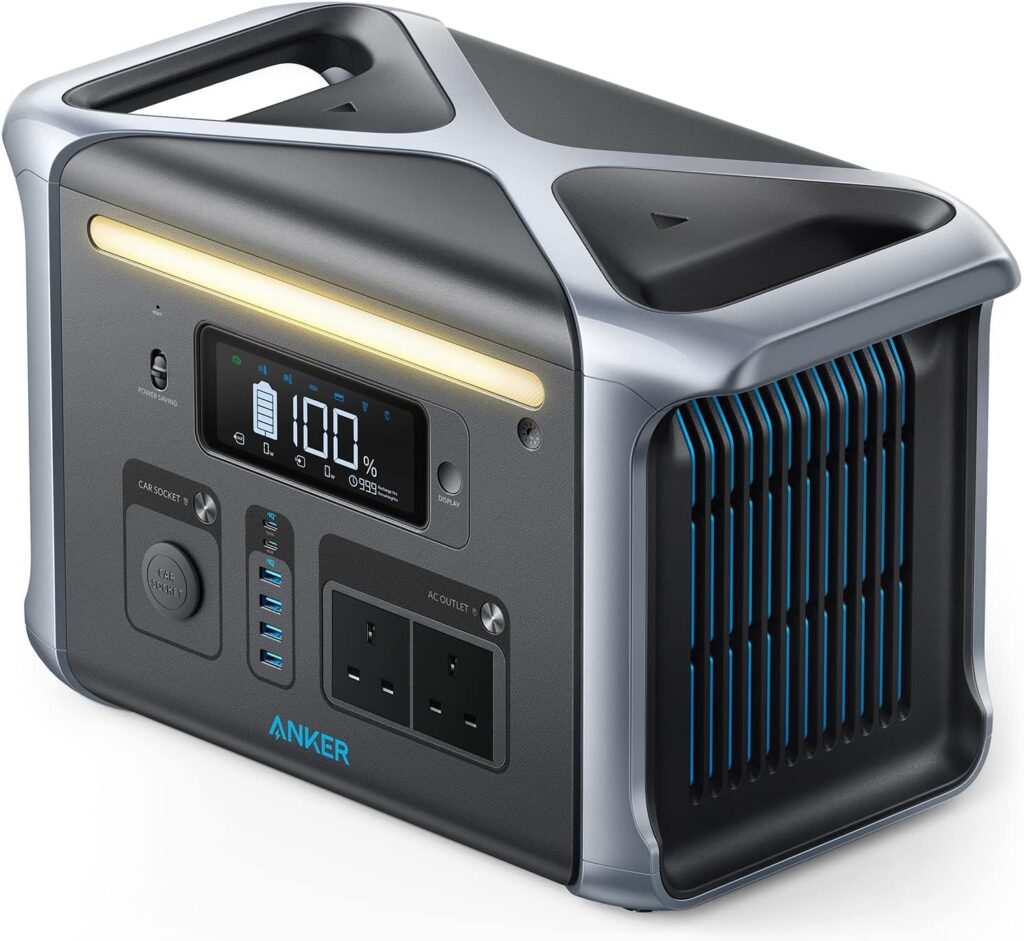 | Anker 757 |
| Sweet spot between power, portability, and expandability | 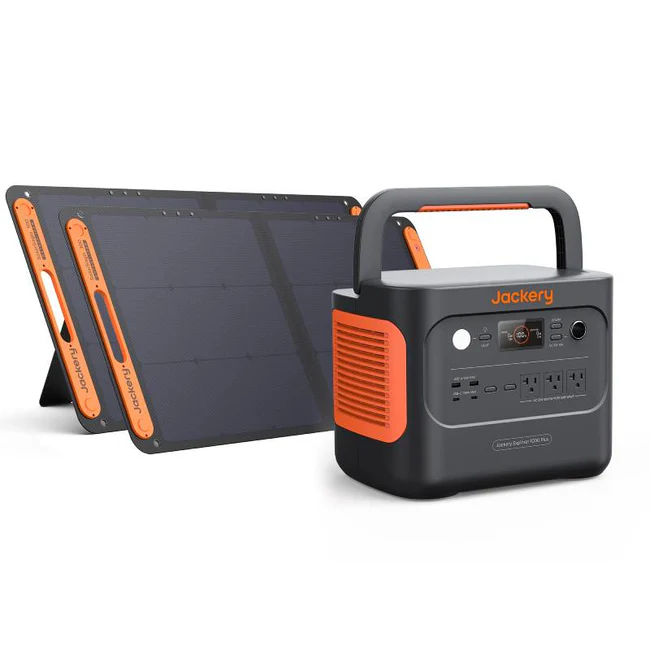 | Jackery Explorer 1000 Plus |
What to Look for in an Emergency Power Station
Before diving into the best models, it’s important to understand what actually matters when you’re choosing a power station for emergencies. I’ve learned that not all units are created equal, and some features really make a difference when you’re in a pinch. Here’s what you should pay attention to:
- Battery Capacity & Output Power
The first thing I always check is the battery capacity, usually measured in watt-hours (Wh). Simply put, watt-hours tell you how much energy the station can store. The higher the number, the longer it can run your devices.
But capacity alone isn’t everything—you also need to look at output power, measured in watts (W). That tells you what kind of devices it can actually run. For example, charging your phone might only require 10–20W, but powering a CPAP machine or a mini-fridge could need 200W or more. If you’re thinking about emergency use, especially for medical gear or family essentials, you’ll want a unit with at least 500Wh of capacity and decent output power to match.
- Portability & Weight
There’s always a trade-off between how powerful a station is and how easy it is to carry. Some of the heavy-duty models can weigh over 40 pounds, which isn’t ideal if you need to move quickly or pack light. On the other hand, lighter models are great for mobility but might not last as long during an extended outage. Personally, I like to think about where I’d store it, how I’d move it, and whether I could lift it comfortably if the power went out at night.
- Recharging Options
A good emergency power station should give you more than one way to recharge it. Most plug into a regular wall outlet, which is great if you have power in advance. But I always look for units that can also charge from a car outlet or a solar panel, since those can be lifesavers when the grid is down. Some even support generator input, which is a nice backup if you already own one. The more options, the better your chances in a real emergency.
- Output Types
Flexibility matters, especially when you’re dealing with different types of gear. I recommend choosing a station with a variety of output ports, like:
- AC outlets for household appliances
- USB-A and USB-C for phones, tablets, and laptops
- DC carports for specific gear like camping lights or air compressors
It’s not just about quantity—it’s about having the right mix for your setup.
- Reliability & Build Quality
In an emergency, the last thing you want is a fragile unit that gives up when you need it most. I always check reviews and specs for build quality—especially models that are known to handle tough conditions, like extreme heat or cold. Solid housing, strong handles, and rugged design can go a long way.
- Safety Features
Finally, safety is a non-negotiable for me. A good power station should have built-in protections like:
- Overload protection (so you don’t fry the system)
- Overheat shut-off (in case it runs too hot)
- Short-circuit protection (to prevent damage or fire)
These features aren’t just marketing fluff—they’re essential when you’re relying on the unit during a power outage.
What to Look for in an Emergency Power Station
Before we go deeper into the models, it’s important to understand what actually matters when you’re choosing a power station for emergencies. I’ve learned that not all units are created equal, and some features really make a difference when you’re in a pinch. Here’s what you should pay attention to:
- Battery Capacity & Output Power
The first thing I always check is the battery capacity, usually measured in watt-hours (Wh). Simply put, watt-hours tell you how much energy the station can store. The higher the number, the longer it can run your devices.
But capacity alone isn’t everything. You also need to look at output power, measured in watts (W). That tells you what kind of devices it can actually run. For example, charging your phone might only require 10–20W, but powering a CPAP machine or a mini-fridge could need 200W or more. If you’re thinking about emergency use, especially for medical gear or family essentials, you’ll want a unit with at least 500Wh of capacity and decent output power to match.
- Portability & Weight
There’s always a trade-off between how powerful a station is and how easy it is to carry. Some of the heavy-duty models can weigh over 40 pounds, which isn’t ideal if you need to move quickly or pack light. On the other hand, lighter models are great for mobility but might not last as long during an extended outage. Personally, I like to think about where I’d store it, how I’d move it, and whether I could lift it comfortably if the power went out at night.
- Recharging Options
A good emergency power station should give you more than one way to recharge it. Most plug into a regular wall outlet, which is great if you have power in advance. But I always look for units that can also charge from a car outlet or a solar panel, since those can be lifesavers when the grid is down. Some even support generator input, which is a nice backup if you already own one. The more options, the better your chances in a real emergency.
- Output Types
Flexibility matters, especially when you’re dealing with different types of gear. I recommend choosing a station with a variety of output ports, like:
- AC outlets for household appliances
- USB-A and USB-C for phones, tablets, and laptops
- DC carports for specific gear, like camping lights or air compressors
It’s not just about quantity. It’s about having the right mix for your setup.
- Reliability & Build Quality
In an emergency, the last thing you want is a fragile unit that gives up when you need it most. I always check reviews and specs for build quality, especially models that are known to handle tough conditions, like extreme heat or cold. Solid housing, strong handles, and rugged design can go a long way.
- Safety Features
Finally, safety is a non-negotiable for me. A good power station should have built-in protections like:
- Overload protection (so you don’t fry the system)
- Overheat shut-off (in case it runs too hot)
- Short-circuit protection (to prevent damage or fire)
These features aren’t just marketing fluff. They’re essential when you’re relying on the unit during a power outage.
Top Picks for Emergency Portable Power Stations
- Jackery Explorer 1000 Plus: Best for balanced performance and solar compatibility

When it comes to emergency preparedness, the Jackery Explorer 1000 Plus hits a sweet spot between power, portability, and future-proofing. This portable power station packs a 1,264Wh LiFePO₄ battery, which offers both a long lifespan and reliable performance during outages. Whether you’re dealing with a power cut at home or heading out for an off-grid adventure, this unit has enough juice to keep your essentials running.
What I like most about the 1000 Plus is how adaptable it is. Out of the box, it’s powerful enough to run appliances like refrigerators, CPAP machines, and even microwaves. But if you want to go bigger, you can expand its capacity up to 5kWh with Jackery’s add-on battery packs, ideal for prolonged emergencies or remote living. And when it’s time to recharge, the 1000 Plus is fast. You can top it up from a wall outlet in under two hours, or take advantage of its solar input and recharge with panels while off-grid.
The Explorer 1000 Plus is also smart. It connects to the Jackery app via Wi-Fi or Bluetooth, letting you monitor charge levels, usage, and settings in real-time. Built with safety and quiet operation in mind, it includes protections like overload and overheat prevention, and it runs silently. It runs less than 30 decibels in quiet mode. For someone who wants reliability, expandability, and ease of use, this model is a strong contender.
Key Features:
- Battery Capacity: 1,264Wh LiFePO₄ battery with ~4,000 charge cycles
- Output Power: 2,000W continuous, 4,000W surge (pure sine wave inverter)
- Expandable System: Compatible with up to 3 battery packs for a total of 5kWh
- Port Options:
- 3 × AC outlets
- 2 × 100W USB-C ports
- 2 × USB-A ports
- 1 × 12V car port
- Recharging Options:
- AC wall outlet (~1.7 hours)
- Solar (up to 400W input, ~2 hours with 4 SolarSaga 200W panels)
- Car socket (~14 hours)
- Smart Control: Wi-Fi and Bluetooth app connectivity
- Safety Features: Overload, short-circuit, and overheat protection
- Build & Portability: Weighs 32 lbs with a foldable handle and durable casing
- Warranty: 5 years (3 years standard + 2 extra with registration)
- EcoFlow DELTA 2: Best for fast charging and high power output

If you’re looking for a power station that combines serious backup power with the ability to recharge nearly as quickly as you’d refill your coffee, the EcoFlow DELTA 2 delivers. It packs a 1,024 Wh LiFePO₄ battery and an 1,800 W continuous inverter (2,700 W surge). This is enough to keep most household essentials going during a blackout or to support multiple devices at a campsite. What really stands out is its X‑Stream charging, which replenishes 0–80% in just 50 minutes, and fully in around 80 minutes via a standard AC wall outlet.
Beyond fast charging, it’s a heavy-duty hub with 15 outputs, including six AC outlets and a suite of USB-C, USB-A, DC5521, and carports, letting you power everything from laptops to a fridge. And if 1 kWh isn’t enough, EcoFlow offers expandable battery capacity: add an extra DELTA 2 battery for 2,048 Wh or a DELTA Max pack to reach 3,040 Wh. True to form, it supports solar recharge via XT60 ports (up to 500 W input), and its built-in UPS (Emergency Power Supply) mode automatically kicks in when grid power fails.
However, this unit is not perfect. You’ll notice fan noise during fast charging, but EcoFlow includes app control to dial charging speed and manage noise levels. Plus, it supports more than 3,000 battery cycles, translating to long-term performance you can rely on.
Key Features:
- Battery Chemistry & Capacity: 1,024 Wh LiFePO₄, ~3,000+ charge cycles
- Power Output:
- 1,800 W continuous (2,700 W surge) pure sine-wave
- X-Boost mode supports up to 2,200 W resistive loads
- Fast Charging:
- 0–80% in ~50 min; full charge in ~80 min via AC (max 1,200 W input)
- Solar & Expandability:
- Solar input up to 500 W via XT60 ports
- Expandable battery options: DELTA 2 or DELTA Max packs for 2–3 kWh total
- Outputs: 4–6 AC outlets, USB-C (100 W), USB-A, car port (12 V/10 A), dual DC5521
- Total Port Count: Up to 15 devices simultaneously
- Smart Control: Wi‑Fi/Bluetooth app; manages charging speed, UPS mode, and firmware
- UPS Feature: Auto-switches to battery within ~30 ms during outage
- Noise Control: Cooling fan is audible at full load; adjustable via app
- Durability: Pure sine wave inverter; LiFePO₄ build lasts longer and is safer
Warranty: 5 years
- Bluetti AC200MAX: Best for large households and heavy‑duty backup

The Bluetti AC200MAX is a powerhouse built for serious emergency preparedness and off-grid living. At its core, it packs a 2,048 Wh LiFePO₄ battery, known for exceptional durability. It lasts over 3,500 cycles to 80% capacity. This means it’s designed to serve you reliably for years. With a 2,200 W continuous inverter (4,800 W surge), it can effortlessly power heavy-duty appliances like refrigerators, power tools, and even air conditioners during an outage. But what really sets it apart is its expandability: add up to two B230 or B300 battery modules, and you can scale your power setup to a staggering 8,192 Wh. This is ideal for long-term home backup or a fully self-sufficient off-grid system.
Despite weighing around 62 lb (28 kg), the AC200MAX is surprisingly thoughtfully designed with sturdy side handles and a full-color touchscreen for easy operation. It also supports simultaneous dual charging; you can recharge via AC and solar input at the same time, reaching up to 1,400 W, so a full recharge from 0% takes just a couple of hours with ideal conditions. For anyone serious about reliable, expandable emergency power, this unit is a game-changer.
Key Features:
- Battery & Lifespan
- 2,048 Wh LiFePO₄ battery
- Rated for ≥3,500 cycles to 80% capacity
- Expandable Capacity
- Supports up to 2 B230 (2,048 Wh) or B300 (3,072 Wh) modules
- Total expandable capacity: up to 6,144 Wh (B230×2) or 8,192 Wh (B300×2)
- Inverter Output
- 2,200 W continuous, 4,800 W surge (pure sine wave)
- Port Selection (up to 16 total)
- 4 × AC outlets
- 1 × 30 A RV (NEMA TT‑30) outlet
- DC: 12V/30A, 12V/10A cigarette, 2 × 12V/10A DC5521
- USB-C 100 W, USB-A fast and standard
- 2 × 15 W wireless charging pads
- Charging & Input Options
- Solar input up to 900 W via MC4 connectors
- AC charging up to 500 W
- Dual AC + solar input allows up to 1,400 W total recharge
- Smart Features
- Bluetooth-enabled with a full-color touchscreen display
- Durability & Build
- Rugged plastic shell with built-in handles
- Weight: ~62 lb (28.1 kg); dimensions ~16.5 × 11 × 15.2 in
- Warranty & Reliability
- Standard 2-year warranty (some regions offer up to 5 years with registration)
- BMS protections: over-voltage, short circuit, temperature control
- Best Use Cases
- Much larger homes or families needing extended backup
- RVs, tiny homes, and off-grid cabins where power needs vary
- Job sites or users running heavy tools and high-wattage appliances
- Anker 757 PowerHouse: Best for portability and build quality

When I first got hands-on with the Anker 757 PowerHouse, I was impressed by its solid construction and thoughtful design. Inside, a 1,229 Wh LiFePO₄ battery pairs with a strong 1,500 W continuous (2,400 W surge) inverter, making it ideal for everything from brewing coffee to keeping a fridge running during a blackout. What really stood out is how fast it recharges, thanks to Anker’s HyperFlash tech, it goes from 0–80% in just one hour using a wall outlet. I’ve used it camping and around the house, and the combination of serious output, swift charging, and rugged build truly delivers peace of mind.
The layout is practical too: six AC outlets, two USB-C (one 100 W, one 60 W), four USB-A ports, and a car socket mean I can run almost everything I need, whether that’s charging phones, running a CPAP, or powering tools. Despite its weight (~44 lb), a top LED light bar, sturdy handles, and clear LCD screen (showing input/output, battery level, and status) make use effortless, even in dim conditions. With built-in UPS capability, you can rely on it to seamlessly support important devices during outages. Anker backs it with a 5-year warranty, and their claim of a 10-year lifespan seems well-grounded when you look at the materials and tech inside.
Key Features
- Battery Capacity & Lifespan:
- 1,229 Wh LiFePO₄ battery, rated for ~3,000 full cycles to 80% (~10 years lifespan)
- Power Output:
- 1500 W continuous (2400 W surge) pure sine-wave inverter
- Recharge Speed:
- 0–80% in ~1 hour, full charge in ~1.5 h via AC (1,000 W input)
- Solar & Car Charging:
- Solar input up to 300 W (XT60), reaching 80% in ~3.6 h with panels
- Car charging ~300 W (~10–14 h full recharge)
- Versatile Ports (13 total):
- 6 × AC outlets
- 2 × USB‑C (100 W, 60 W), 4 × USB‑A (12 W each)
- 1 × 12 V car socket (120 W)
- Built-in Light & Display:
- LED light bar (multi‑mode including SOS)
- 5″ LCD shows real-time power metrics
- UPS Functionality:
- Sub‑20 ms automatic switch-over during power loss
- Durable Build & Warranty:
- Impact‑resistant unibody, automotive‑grade aluminum frame, dual handles
- 5‑year warranty with components rated to 50,000 hours
- Weight & Dimensions:
- ~19.9 kg (43.9 lb); 18.2 × 11.3 × 9.3 in
- Goal Zero Yeti 500X: Best for off‑grid use and rugged environments

I’ll admit. I wasn’t expecting a portable power station under 13 lb to feel so solid, yet the Yeti 500X packs a surprising punch. It houses a 505 Wh lithium-ion battery, paired with a 300 W continuous (600 W surge) pure sine-wave inverter, which is enough to keep a small fridge, CPAP machine, or several laptops running smoothly. Its compact design, around the size of a car battery, makes it easy to store or grab for spin‑up adventures. Goal Zero also built it for outdoor durability, with an anodized aluminum exterior and corner protection that stands up to campsites and trailheads.
One of its strongest qualities is versatility. You’ll find two AC outlets, two USB-A ports, a 60 W USB‑C PD port (with laptop‑level power), a regular USB‑C port, a 12‑V car port, and a 6‑mm barrel port. Charge it however makes sense: wall outlet (~9 hours), car (~4–7 hours), or solar (8 mm or USB‑C) with MPPT support for faster recharge. Reviews confirm its reliability: users have run laptops all day, fridges for hours, and even weathered storm‑related power outages with confidence.
In one sentence, if you’re heading off-grid or want a dependable emergency backup that balances portability with capability, the Yeti 500X is a solid pick.
Key Features
- Battery capacity: 505 Wh lithium-ion
- Inverter: 300 W continuous, 600 W surge; pure sine wave
- Ports:
- 2 × 120 V AC
- 2 × USB‑A (5 V, up to 2.4 A)
- 1 × USB‑C PD (60 W input/output)
- 1 × USB‑C (18 W)
1 × 12 V car port - 1 × 6 mm barrel port
- Charging options:
- Weight & size: ~12.9 lb (5.85 kg); 7.5 × 11.3 × 5.8 in
- Durable construction: Anodized aluminum shell with corner protection
- Display: Backlit LCD shows wattage in/out, estimated runtime, volts, amps
- MPPT solar controller: Boosts solar input by ~30% vs. PWM
- Warranty: 2‑year (US)
- Zendure SuperBase Pro 2000: Best for high-tech features and app control

When I discovered the Zendure SuperBase Pro 2000, I was blown away by how cutting-edge it is, think suitcase-sized power station, complete with 4G/IoT, GPS, and performance-tracking. With a 2,096 Wh Li-NMC battery and a 2,000 W continuous inverter (with peaks up to 4,000 W via AmpUp), it’s ready to power everything from fridges and TVs to power tools and electric grills. What makes it stand out even more is its insane recharge speed: you can get 80% charge in just one hour using solar, AC, or a combo setup, and a full recharge in about two hours.
Despite weighing ~46–48 lb, it’s surprisingly portable thanks to built-in wheels and a telescoping handle, like suitcase luggage that rolls over rough terrain. The ports are well thought out. It features six AC outlets angled for easy access, four USB-C (two 100 W + two 20 W), three DC 12 V/10 A (DC5521), plus a 12 V car port. The 6.1” color display keeps you informed with power stats, connectivity status, and carbon-saving numbers via ZenForest.
This unit is perfect for anyone who wants a smart, robust, and fast-recharging system they can monitor from anywhere. Whether you’re prepping for emergencies or need on-the-go power for an RV or jobsite, the SuperBase Pro 2000 checks all the boxes.
Key Features
- Battery & Capacity: 2,096 Wh Li-NMC (EV-grade), 1,500 cycles to 80% capacity
- Inverter Output: 2,000 W continuous (4,000 W surge via AmpUp)
- Recharge Speed:
- 80% in ~1 h, full charge in ~2 h (AC 1,800 W or solar + AC combo up to 2,400 W)
- Solar input: AC-side up to 1,800 W or DC XT60 up to 600 W
- Ports (14 total):
- 6 × AC outlets (100–120 V)
- 1 × 12 V car port (13.6 V/10 A)
- 3 × DC5521 outputs (13.6 V/10 A)
- USB-C: 2 × 100 W + 2 × 20 W
- Smart Connectivity:
- Wi‑Fi & built‑in 4G LTE + GPS tracking
- Control via Zendure app (monitor performance, location, firmware, schedule)
- UPS Functionality: <15 ms switchover, protects essentials during outages
- Portability:
- Wheeled “luggage” design with telescoping + fixed handle
- Size: ~44 × 28 × 25 cm; weight: ~21 kg (46.5 lb)
- Display & Interface:
- 6.1” color touchscreen showing power, runtime, carbon savings via ZenForest
- Durability & Build:
- Rugged shell with corner protection & impact-resistant interior
- Warranty: 2 years standard
- Eco Features: ZenForest tracks and plants trees via carbon offset
Comparison Table of These 6 Models
| Model | Capacity (Wh) | Max Output (W) | Recharge Time | Weight | Price Range | Ideal Use |
| Jackery Explorer 1000 Plus | 1,264 (expandable to 5,048) | 2,000 W (4,000 W peak) | ~1.7 hrs (AC), 2 hrs (solar) | 32 lbs (14.5 kg) | ~$1,199+ | Balanced performance, solar compatibility |
| EcoFlow DELTA 2 | 1,024 (expandable to 3,040) | 1,800 W (2,700 W surge) | ~80% in 50 mins (AC) | 27 lbs (12 kg) | ~$999+ | Fast charging, versatile power |
| Bluetti AC200MAX | 2,048 (expandable to 8,192) | 2,200 W (4,800 W surge) | ~2 hrs (AC), ~3.5 hrs (solar) | 61.9 lbs (28 kg) | ~$1,599+ | Heavy-duty backup, large households |
| Anker 757 PowerHouse | 1,229 | 1,500 W (2,400 W surge) | ~1.5 hrs (HyperFlash™) | 43.9 lbs (19.9 kg) | ~$1,399 | Reliable, durable, and great build |
| Goal Zero Yeti 500X | 505 | 300 W (600 W surge) | ~9 hrs (AC), ~6 hrs (solar) | 12.9 lbs (5.85 kg) | ~$549 | Light use, off-grid camping, compact backup |
| Zendure SuperBase Pro 2000 | 2,096 | 2,000 W (4,000 W AmpUp) | ~80% in 1 hr (AC or solar) | 46.5 lbs (21 kg) | ~$1,899+ | High-tech features, app control, rapid charging |
How to Use Portable Power Stations in Emergencies
When the lights go out or you’re cut off from the grid, a portable power station can feel like a lifeline. But owning one is just part of the equation. You’ve also got to know how to use it right. Here’s how I approach emergency readiness with my power station, and how you can do the same.
- Prepping and Charging Ahead of Time
The number one rule? Charge your unit before you need it. I always keep mine at 80–100% when storms are forecast or wildfire season ramps up. Some stations, like the EcoFlow or Jackery, even let you set automatic charge schedules using their companion apps.
If you have a solar panel setup, it’s smart to test everything out on a clear day before you need it. Know how long it takes to recharge and how the output behaves with cloud coverage. Emergencies aren’t the time for trial and error.
Tip: If your power station has a UPS (uninterruptible power supply) function, you can keep it plugged in so it stays topped off and switches instantly when the grid goes down.
- Running Essential Devices
Not everything in your house should plug into your power station. You want to prioritize essentials, mostly things that support safety, health, and communication. I typically run:
- CPAP machines (with DC converters for max efficiency)
- Wi-Fi routers and phones (for staying informed)
- LED lights or lanterns
- Mini-fridges or coolers (especially for medication or baby formula)
- Laptops or radios (for work or emergency broadcasts)
A good rule of thumb: calculate watt usage and time. For example, if your fridge uses 100W and your power station has 1,000Wh, that’s about 10 hours of runtime. Always leave a buffer.
Tip: Use the DC or USB outputs when possible. They’re more efficient than AC outlets.
- Using with Solar Panels
If you plan to go solar (and you should, for longer outages), make sure your panel setup is compatible and powerful enough for your power station. I recommend:
- 100W–200W foldable solar panels for compact units like the Yeti 500X
- 300W–600W or more for larger models like the Bluetti AC200MAX or SuperBase Pro
You’ll get the best results by placing panels at a 30–45° angle, tilted toward the sun, and adjusting them every few hours. On cloudy days, performance drops dramatically. Plan to double or triple your panel wattage just in case.
Tip: Use MPPT charging ports when available. They extract more power from solar under varying conditions.
- Maintenance and Storage Tips
Your power station’s battery won’t last forever, but proper care can stretch its lifespan well beyond 5 years. Here’s what you should do:
- Store at room temperature, ideally between 50°F and 80°F (10°C–27°C)
- Keep it ~50–80% charged if you’re not using it for long periods
- Recharge every 3–6 months, especially in winter
- Keep dust and moisture out. Store it in a dry bin or protective case if needed
Also, update the firmware when prompted (if your unit supports Wi-Fi or app control). It’s like keeping your phone or laptop up to date, which is important for both safety and performance.
Tip: Once a month, do a full test run. Power up a few devices, check charge time, and make sure everything’s running as expected.
Bottom Line & Recommendation
From what I have walked you through in our quest to identify the best portable power stations for emergency use, one thing is clear: not all units are created equal, but the right one can make all the difference when the lights go out.
If you’re looking for versatility and power, the Bluetti AC200MAX and Zendure SuperBase Pro 2000 are the main contestants. They offer huge capacity, fast recharging, and can handle just about anything, from CPAP machines to refrigerators to entire workstations. For a balanced, solar-ready option that’s also expandable, the Jackery Explorer 1000 Plus is a fantastic middle ground. It’s lightweight enough for portable use but strong enough to serve as a central emergency hub, especially if you plan to use solar panels for long-term backup.
On the other hand, if speed and smart features matter most, the EcoFlow DELTA 2 is a brilliant choice with its rapid recharge times and app-based controls.
Having said that, your decision should come down to your personal emergency needs. Ask yourself:
Do you just want to keep phones and lights on during a short blackout?
Or do you need to run medical gear, a fridge, or even work equipment during extended outages?
For lighter needs or tight budgets, something like the Goal Zero Yeti 500X offers peace of mind in a small, reliable package. And if you’re after all-around durability and a great build, the Anker 757 is a dependable go-anywhere option.
Remember, a portable power station isn’t just another gadget. It’s an investment in safety, comfort, and preparedness. Whether you’re facing a winter storm, wildfire risk, or a shaky grid, having backup power ready means fewer worries and more control.
So take a little time now to prep. Because when the next outage hits, you’ll be glad you did.
